| 16 April |
• yesterday • tomorrow |
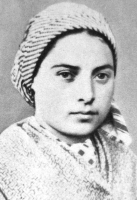
• Bernardette Soubirous
• Sleeping Saint of Nevers
• Bernada, Bernardetta, Bernardette, Maria Bernadette, Marie Bernarde
18 February in France
Oldest of six children born to François and Louise Casterot, and grew up very poor. Hired out as a servant from age 12 to 14. Shepherdess. On 11 February 1858, around the time of her first Communion, she received a vision of the Virgin; her own account of it is in the Readings section below. She received seventeen more in the next five months, and was led to a spring of healing waters. She moved into a house with the Sisters of Nevers at Lourdes where she lived, worked, and learned to read and write. The sisters cared for the sick and indigent, and at age 22 they admitted Bernadette into their order since she was both. Always sick herself, and often mistreated by her superiors, she died with a prayer for Mary's aid. Since the appearances of Mary to young Bernadette in 1858, more than 200 million people have visited the shrine of Lourdes.
7 January 1844 at Lourdes, Hautes-Pyrénées, France
• 16 April 1879, Nevers, Nièvre, France of natural causes
• body incorrupt
• the sisters covered the body in wax, and it is on display in Nevers
8 December 1933 by Pope Pius XI
• against bodily ills, illness and sickness
• against poverty
• Lourdes, France
• people ridiculed for their piety
• poor people
• shepherdesses
• shepherds
• sick people
Nothing is anything more to me; everything is nothing to me, but Jesus: neither things nor persons, neither ideas nor emotions, neither honor nor sufferings. Jesus is for me honor, delight, heart and soul. - Saint Bernadette
You must receive God well; give Him a loving welcome, for then He has to pay us rent. - Saint Bernadette
The more I am crucified, the more I rejoice. - Saint Bernadette Soubirous
I had gone down one day with two other girls to the bank of the river Gave when suddenly I heard a kind of rustling sound. I turned my head toward the field by the side of the river, but the trees seemed quite still and the noise was evidently not from them. Then I looked up and caught sight of the cave where I saw a lady wearing a lovely white dress with a bright belt. On top of each of her feet was a pale yellow rose, the same color as her rosary beads. At this I rubbed my eyes, thinking I was seeing things, and I put my hands into the fold of my dress where my rosary was. I wanted to make the sign of the cross, but for the life of me I couldn't manage it, and my hand just fell down. Then the lady made the sign of the cross herself, and at the second attempt I managed to do the same, though my hands were trembling. Then I began to say the rosary while the lady let her beads clip through her fingers, without moving her lips. When I stopped saying the Hail Mary, she immediately vanished. I asked my two companions if they had noticed anything, but they said no. Of course, they wanted to know what I was doing, and I told them that I had seen a lady wearing a nice white dress, though I didn't know who she was. I told them not to say anything about it, and they said I was silly to have anything to do with it. I said they were wrong, and I came back next Sunday, feeling myself drawn to the place…. The third time I went, the lady spoke to me and asked me to come every day for fifteen days. I said I would and then she said that she wanted me to tell the priests to build a chapel there. She also told me to drink from the stream. I went to the Gave, the only stream I could see. Then she made me realize she was not speaking of the Gave, and she indicated a little trickle of water close by. When I got to it I could only find a few drops, mostly mud. I cupped my hands to catch some liquid without success, and then I started to scrape the ground. I managed to find a few drops of water, but only at the fourth attempt was there sufficient for any kind of a drink. The lady then vanished and I went back home. I went back each day for fifteen days, and each time, except one Monday and one Friday, the lady appeared and told me to look for a stream and wash in it and to see that the priests build a chapel there. I must also pray, she said, for the conversion of sinners. I asked her many times what she meant by that, but she only smiled. Finally, with outstretched arms and eyes looking up to heaven, she told me she was the Immaculate Conception. During the fifteen days she told me three secrets, but I was not to speak about them to anyone, and so far I have not. - from a letter by Saint Bernadette
https://catholicsaints.info/saint-bernadette-of-lourdes/
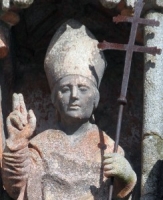
Son of a Gothic general, and member of a noble military family. Studied at the seminary in Palencia. From an early age, Fructuosus felt a call to the religious life. Orphaned when young. When he came of age, Fructuosus gave away his family fortune to the poor, bought the freedom of slaves, and founded several monasteries. By 647 he had founded houses in Lusitania, Asturia, Spanish Galicia, and the island of Gades.
Feeling that he lacked contact with God, Fructuosus left the houses and friends, and became a hermit in the desert of Galacia. His reputation for holiness and wisdom attracted students, sometimes entire families. He built monasteries for them, placed them under the Benedictine Rule, and served as abbot. He attracted so many disciples that the king limited the number of men who could join; he feared there would not be enough young men to man the army.
Again feeling that the outside world was taking too much of this time, Fructuosus planned to flee further into the wilderness, this time to the deserts in Egypt. However, the king got word of the plan, decided too many people depended on his leadership, and ordered him not to leave the country. Bishop of Dumium in 654. Archbishop of Braga, Portugal in 656. Wrote two monastic rules, one of which was designed to allow families to remain together, yet live monastic lives.
early 7th century Spain
• 16 April 665
• his deathbed was a pile of ashes he had placed before the altar
• relics translated to Santiago de Compostela, Spain in 1102
• his tomb became a place for pilgrimages, and a scene of miracles
monk with a stag, which relates to a story that he saved one from hunters, and it became a devoted pet
One day he was going through a forest, when a roe, pursued by hunters, took refuge under his cloak. The Saint took the animal under his protection, and brought it to the monastery. The grateful beast never quitted his liberator; it followed him about all day, slept at his feet at night, and never ceased to cry when he was absent. More than once he had it taken back to the forest, but it always found the track of its deliverer’s footprints. At last it was one day killed by a young man who disliked monks. Fructuosus was absent for a few days, and on his return he was surprised not to see his roe run to meet him, and when he heard that it was dead, he was overcome with grief, his knees trembled, and he prostrated himself on the floor of the church. It is not related whether this was to ask God to punish the cruel man; but the latter soon fell ill, and sent for the Father to come to his assistance. Fructuosus took the revenge of a noble Visigoth and Christian. He cured the murderer of his roe, and restored him to health both of soul and body. It is related of him that, wishing to escape the homage of the people, he retired into the depth of the forest, and that the jays which he had brought up in the monastery sought him out and betrayed the place of his retreat by the joyous chattering with which they greeted him. Fructuosus is painted with a roe and jays as his emblems. – from "The Little Bollandists" by Monsignor Paul Guérin, 1882
https://catholicsaints.info/saint-fructuosus-of-braga/
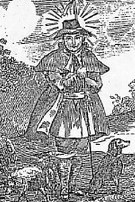
Dreux, Drugo, Druon
Born to the Flemish nobility. His mother died giving him birth, a fact that emotionally crushed him when he learned of it at age 10; he imagined himself responsible for her death. Later in life he practiced extreme penances, possibly to expiate this guilt. Orphaned in his teens. At 18, he disposed of all his property and became a penitential pilgrim, making nine trips to Rome, Italy. Shepherd for six years at Sebourg, near Valencienne, France, working for Elizabeth de la Haire. Revered for his holiness. Reportedly able to bilocate, with witnesses seeing him simultaneously working the fields and attending Mass. Stricken with an unsightly bodily affliction during a pilgrimage, he became a hermit at Sebourg in Hainault for 40 years surviving on barley, water, and the Eucharist.
1105
c.1186 at Seboug, France
• against bodily ills
• against broken bones
• against deafness
• against dumbness
• against gall stones
• against hernias
• against illness
• against insanity
• against mental illness
• against muteness
• against ruptures
• against sickness
• Baume-les-Messieurs
• cattle
• coffee house keepers
• coffee house owners
• deaf people
• Fleury-sur-Loire
• mentally ill people
• midwives
• mute people
• mutes
• orphans
• sheep
• shepherds
• sick people
• unattractive people
Benedictine with sheep
https://catholicsaints.info/saint-drogo/
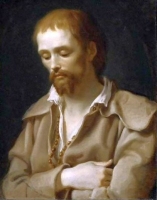
• Beggar of Perpetual Adoration
• Benedetto Giuseppe Labre
Oldest of fifteen children in a prosperous middle class family. Educated by his uncle, a parish priest. Following his uncle's death, he tried to join the Trappists, Carthusians, and Cistercians, but was rejected by them all. He spent years wandering Europe, especially Rome, Italy, in complete poverty, spending his days in perpetual adoration in the cathedrals. Given to religious ecstacies when contemplating the crown of thorns; reputed to float, soar, and bilocate when in these swoons. He begged in the streets, and if he was given more than he needed for the day, he would give the remainder to some one he considered more in need than he was. Benedict healed some of his fellow homeless, and was reported to have multiplied bread for them. Noted counselor to people of all walks in Rome. He died in a hospice, exhausted from his life of austerity. His biography, written by his confessor Marconi, describes 136 miraculous cures attributed to him within three months of his death.
25 March 1748 at Amettes, Boulogne, France
• 17 April 1783 at Rome, Italy
• interred at the Church of Santa Maria ai Monti, Rome
8 December 1881 by Pope Leo XIII
• against insanity and mental illness
• bachelors
• beggars
• hoboes
• homeless people
• mentally ill people
• people rejected by religious orders
• pilgrims
• tramps
• unmarried men
beggar in a tri-cornered hat sharing his alms
https://catholicsaints.info/saint-benedict-joseph-labre/

• Magnus Erlendsson of Orkney
• Magnus Erlendsson
• Magnus the Martyr
• Mans...
13 December (translation of relics)
Born to a Viking family, son of Erlend Thorfinnsson, Earl of Orkney; related to King Olav II and King Harald II of Norway. He was raised as a pagan and lived as a pirate. Convert to Christianity, which made him unpopular in the Norwegian royal court especially when he refused to fight Christians. Earl of the Orkney Islands from 1108 to 1115. Killed during a political struggle with the pagan Norwegian elements for control of the Christian areas under his rule, and thus considered a martyr. Two sagas have been written about his life.
c.1075 in the Orkney Islands, Scotland
• struck in the head with an axe in 1115 at Egilsay Island, Scotland
• his last words were reported to a prayer asking for forgiveness of his killer
• buried in Christ Church, Birsay, Orkland, Scotland
• re-interred in cathedral of Saint Magnus in Kirkwall, Orkney, Scotland in 13 December 1137
• relics rediscovered during excavations in 1919
Orkney Islands
• palm
• ship
https://catholicsaints.info/saint-magnus-of-orkney/
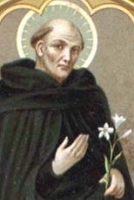
• Gioacchino Piccolomini
• Joachim of Siena
3 February (Servites)
Born to the Sienese nobility. A pious youth, noted for a devotion to the Blessed Virgin, and for giving all he had to the poor. Servite lay-brother at age 14. Spiritual student of Saint Philip Benizi. Urged by his brothers to study for the priesthood, Joachim felt he was not worthy, and aspired no higher than to be an altar server. He became so well known for his sanctity that he requested the Servites transfer him to Arezzo to escape devotees. The move caused such a stir of complaints in Siena that he was ordered to return.
1258 at Siena, Italy
16 April 1306 at Siena, Italy of natural causes
• 21 March 1609 by Pope Paul V
• 9 January 1926 by Pope Pius XI (decree on heroic virtues)
against epilepsy
Servite holding a book and flower
https://catholicsaints.info/blessed-joachim-piccolomini/
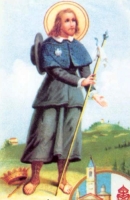
Contardo the Pilgrim
last Saturday in August (translation of relics)
Eldest son in a family of Italian nobility, he gave up wealth and the world for piety and poverty, and died while on pilgrimage to Santiago de Compostella, Spain.
1216 in Ferrara, Italy
• 16 April 1249 in Broni, Pavia, diocese of Tortona, Italy of natural causes
• legend says that at his death all the local church bells began to ring, and flames were seen to flicker around his body to indicate his holiness
• buried in Broni
• by Pope Paul V (cultus confirmation)
• by Pope Urban VIII (indulgences approved for devotions)
https://catholicsaints.info/blessed-contardo-deste/
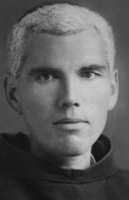
Gaspër
Studied philosphy and theology in Shkodrë, Albania, the Austrian cities of Vienna, Grac and Lankowitz, and in Genoa, Italy. Ordained a priest in Genoa on 24 July 1921. Franciscan Friar Minor. Taught at the seminary in Shkodrë. Imprisoned for his faith by Communists authorities on 24 May 1948, he was given a show trial and sentenced to prison where he died. Martyr.
23 March 1897 in Shkodrë, Albania
16 April 1950 at the Great Prison in Shkodrë, Albania of cancer
• 5 November 2016 by Pope Francis
• beatification celebrated at the Square of the Cathedral of Shën Shtjefnit, Shkodër, Albania, presided by Cardinal Angelo Amato
https://catholicsaints.info/blessed-mikel-suma/
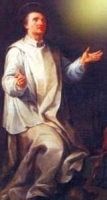
As a boy he survived the politically inspired massacred of the rest of his family. Entered the Canons Regular of Santa Maria di Reno. Priest. Lived at the Saint Ambrose convent at Gubbio, Italy in 1498. His reputation for holiness attracted the humble and powerful. Repeatedly refused the archbishopric of the city.
1460 in Bologna, Italy
• 16 April 1513 in Gubbio, Italy of an intense fever
• interred at the Saint Ambrose convent, Gubbio on 3 December 1513
• body incorrupt
2 October 1748 by Pope Benedict XIV
https://catholicsaints.info/blessed-arcangelo-canetoli/
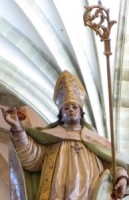
Toribi, Toribio, Turrybiusz
Bishop of Astorga in northwest Spain. Known as a stern disciplinarian. Fierce opponent of Priscillianist heresy. Great supporter of Pope Saint Leo the Great.
c.402 in Betanzos, Visigothic kingdom of Toledo (in modern Spain
• c.460 in Tui, Spain of natural causes
• buried at the monastery of Santo Toribio de Liébana, Cantabria, Spain
• city of Astorga, Spain
• diocese of Astorga, Spain
https://catholicsaints.info/saint-turibius-of-astorga/

Lamberto, Lambertus
16 April as one of the Martyrs of Zaragoza
Farmer and servant during the period of Muslim occupation of Spain. Martyred by his Saracen master.
• beheaded c.900
• jawbone enshrined in Maastricht, Netherlands
• monastery named for his was built on the trditional site of his execution in 1522; it was destroyed in 1808
https://catholicsaints.info/saint-lambert-of-saragossa/
Having survived the official persecutions of Diocletian, Lambert was murdered by local pagans who refused to accept any toleration of Christianity. Martyr.
306 near Saragossa, Spain
https://catholicsaints.info/saint-lambert-of-saragossa-2/
Herve
Monk and treasurer of the Saint Martin of Tours Abbey where, though he was one of the brothers, he lived as a hermit.
at Touraine, France
1021
https://catholicsaints.info/saint-herveus-of-tours/
Guglielmo Gnoffi
Atoned for a sinful youth by living as an extremely austere and penetential hermit.
at Polizzi, Italy
c.1317 of natural causes
https://catholicsaints.info/saint-william-gnoffi/
Vasius, Vaize
Wealthy citizen of Saintes, France who was imprisoned and murdered by his relatives for giving his property to the poor. Martyr.
c.500
https://catholicsaints.info/saint-vaise/
Monk. Abbot of the Saint Martin the Great Abbey in Ireland in 1020. Abbot of Saint Panteleon Abbey in Cologne, Germany.
Ireland
1042
https://catholicsaints.info/saint-elias/
2 January as one of the Martyrs of Anjou
A group of lay people who were executed together for their faith during the anti-Christian persecutions of the French Revolution.
• Anne Maugrain
• François Micheneau veuve Gillot
• François Suhard veuve Ménard
• Jean Ménard
• Jeanne Gourdon veuve Moreau
• Jeanne Leduc épouse Paquier
• Jeanne Onillon veuve Onillon
• Jeanne Thomas veuve Delaunay
• Madeleine Cady épouse Desvignes
• Madeleine Sallé épouse Havard
• Marguerite Robin
• Marie Forestier
• Marie Gingueneau veuve Coiffard
• Marie Lardeux
• Marie Piou épouse Supiot
• Marie Rechard
• Marie Roger veuve Chartier
• Marie-Genevieve Poulain de la Forestrie
• Marthe Poulain de la Forestrie
• Perrine Bourigault
• Perrine Laurent
• Perrine Pottier épouse Turpault
• Pierre Delépine
• Renée Bourgeais veuve Juret
• Renée Rigault épouse Papin
• Renée Sechet veuve Davy
16 April 1794 at Avrillé, Maine-et-Loire, France
19 February 1984 by Pope John Paul II at Rome, Italy
https://catholicsaints.info/martyrs-of-avrille-16-april/

A group of eight Christians who were tortured and martyred together in the persecutions of Decius. We know little more than their names - Basilisa, Callistus, Charisius, Leonide, Galina, Nica, Nunencia and Teodora.
thrown into the sea at Corinth, Greece c.250
https://catholicsaints.info/martyrs-of-corinth-16-april/
Group of eighteen martyrs murdered in 304 in Saragossa, Spain in the persecutions of Diocletian and the prefect Dacean. We know little more than the names - Apodemus, Caecilian, Caius, Crementius, Engratia, Eventius, Felix, Fronto, Gaius, Julia, Lambert, Lupercus, Martial, Optatus, Primitivus, Publius, Quintilian, Saturnius (4 men of this name), Succesus and Urban.
graves re-discovered in 1389 in the crypt under the church of San Encrazia in Saragossa
https://catholicsaints.info/martyrs-of-saragossa/
• Hugh de Mataplana
• Tetgaill of Lann-Ela
CatholicSaints.Info Portable Edition